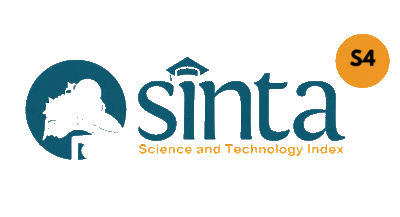SISTEM PAKAR APLIKASI DIAGNOSA PENYAKIT DALAM BERBASIS WEBSITE
DOI:
https://doi.org/10.47111/jti.v18i2.14046Keywords:
Expert system, website, internal medicine, diagnosis, web technologyAbstract
An internal medicine expert system is an application designed to assist in the process of diagnosing diseases based on symptoms experienced by patients. In today's digital era, the use of web-based expert systems is growing because it provides wider accessibility to users. This research aims to implement a website-based internal medicine expert system as a diagnosis tool for the general public. This system development method involves the steps of needs analysis, system design, implementation, and evaluation. In the needs analysis phase, data on disease symptoms and related medical information were collected to build the expert system knowledge base. Based on the analysis, a user-friendly website interface was designed as well as an algorithm for matching symptoms with corresponding diseases. Implementation was done using web technologies such as HTML, CSS, and JavaScript to build an interactive and responsive user interface. System evaluation was conducted through functionality and diagnosis accuracy trials involving a number of sample disease cases. The evaluation results show that the web-based internal medicine expert system is able to provide a fairly accurate diagnosis according to the symptoms entered by the user. Thus, the implementation of this system can be an effective solution in helping people to make an initial diagnosis of the disease.
Downloads
References
A. Al-Makki et al., “Hypertension pharmacological treatment in adults: A world health organization guideline executive summary,” Hypertension, vol. 79, no. 1, pp. 293–301, Jan. 2022, doi: 10.1161/HYPERTENSIONAHA.121.18192.
F. J. Charchar et al., “Lifestyle management of hypertension: International Society of Hypertension position paper endorsed by the World Hypertension League and European Society of Hypertension,” J Hypertens, vol. 42, no. 1, pp. 23–49, Jan. 2024, doi: 10.1097/HJH.0000000000003563.
Li Zhou, Margarita Sordo, Chapter 5 - Expert systems in medicine, Editor(s): Lei Xing, Maryellen L. Giger, James K. Min, Artificial Intelligence in Medicine, Academic Press, 2021, Pages 75-100, ISBN 9780128212592, https://doi.org/10.1016/B978-0-12-821259-2.00005-3.
A. Saibene, M. Assale, and M. Giltri, “Expert systems: Definitions, advantages and issues in medical field applications,” Expert Systems with Applications, vol. 177. Elsevier Ltd, Sep. 01, 2021. doi: 10.1016/j.eswa.2021.114900.
H. R. Banjar et al., “Web-based expert system with quick response code for beta-thalassemia management,” Health Informatics J, vol. 27, no. 1, 2021, doi: 10.1177/1460458221989397.
D. Olabanji1, T. Fitch1, and O. Matthew1, “Cloud-native architecture Portability Framework Validation and Implementation using Expert System,” UK, Apr. 2023.
B. T. Sayed, “APPLICATION OF EXPERT SYSTEMS OR DECISION-MAKING SYSTEMS IN THE FIELD OF EDUCATION,” IT in Industry, vol. 9, no. 1, p. 2021, 2021.
H. Henderi, E. Rahwanto, T. Wahyuningsih, and A. Badrianto, “Expert System Application for Troubleshooting and Maintaining Epson L3110 Printer,” PIKSEL : Penelitian Ilmu Komputer Sistem Embedded and Logic, vol. 9, no. 1, pp. 29–44, Mar. 2021, doi: 10.33558/piksel.v9i1.2429.
H. Mayatopani, “EXPERT SYSTEM FOR DIAGNOSING BEHAVIORAL DISORDERS USING THE DEMPSTER-SHAFER THEORY ALGORITHM,” TEKNOKOM, vol. 7, no.
, pp. 172–179, Feb. 2024, doi: 10.31943/teknokom.v7i1.181.
S. Mainali, M. E. Darsie, and K. S. Smetana, “Machine Learning in Action: Stroke Diagnosis and Outcome Prediction,” Frontiers in Neurology, vol. 12. Frontiers Media S.A., United States, Dec. 06, 2021. doi: 10.3389/fneur.2021.734345.
E. A. Algehyne, M. L. Jibril, N. A. Algehainy, O. A. Alamri, and A. K. Alzahrani, “Fuzzy Neural Network Expert System with an Improved Gini Index Random Forest-Based Feature Importance Measure Algorithm for Early Diagnosis of Breast Cancer in Saudi Arabia,” Big Data and Cognitive Computing, vol. 6, no. 1, Mar. 2022, doi: 10.3390/bdcc6010013.
M. Martínez-Lacalzada et al., “Predicting critical illness on initial diagnosis of COVID-19 based on easily obtained clinical variables: development and validation of the PRIORITY model,” Clinical Microbiology and Infection, vol. 27, no. 12, pp. 1838–1844, Dec. 2021, doi: 10.1016/j.cmi.2021.07.006.
M. Mahbubur Rahman, M. Rahman Rana, M. Nur-A-Alam, M. Saikat Islam Khan, and K. Mohammad Mohi Uddin, “A web-based heart disease prediction system using machine learning algorithms,” Bangladesh, 2022. [Online]. Available: www.iaees.org
T. K. Putri, M. L. Arnumukti, K. Khatimah, E. Zalsabila, and S. Sudianto, “Diabetes Diagnostic Expert System using Website-Based Forward Chaining Method,” Journal of Dinda Data Science, Information Technology, and Data Analytics, vol. 3, no. 1, pp. 11–17, 2023, [Online].
Available: http://journal.ittelkom-pwt.ac.id/index.php/dinda
R. Ardiansyah, “Analysis and Application of the Certainty Factor Method in the Diagnostic Expert System for Broiler Chicken Diseases,” Journal of Computer Scine and Information Technology, pp. 66–71, Apr. 2023, doi: 10.35134/jcsitech.v9i2.65.
M. Syamsuri Rachman, S. Tinggi Agama Islam Nurul Hidayah Malingping Lebak, and U. Islam Negeri Sultan Maulana Hasanuddin Banten, “Characteristics of Students: a Library Study,” Apr. 2021.
P. Suherni, “Aplikasi Sistem Informasi Transaksi Pelayanan Obat Di Apotek Menggunakan Metode Waterfall,” Riau, 2021.
A.-A. Solehudin, N. Wahyu, N. Fariz, R. F. Permana, and A. Saifudin, “Rancang Bangun Digitalisasi Persediaan Barang Berbasis Web Menggunakan Metode Waterfall,” Tangerang Selatan, Jun. 2023. [Online]. Available: https://journal.mediapublikasi.id/index.php/logic
E. Sitepu, M. Simanjuntak, and H. Khair, “SISTEM PAKAR MENDIAGNOSA PENYAKIT KELAINAN DARAH PADA MANUSIA MENGGUNAKAN METODE BAYES BERBASIS
WEB,” Jurnal Teknik Informatika Kaputama (JTIK), vol. 6, no. 1, 2022.
S. N. Yanti and E. Budiyati, “Aplikasi Sistem Pakar untuk Mendiagnosa Virus Covid-19 pada Manusia Berbasis Web Menggunakan Metode Forward Chaining,” Jurnal Informatika Universitas Pamulang, vol. 5, no. 4, p. 451, Dec. 2021, doi: 10.32493/informatika.v5i4.4944.












